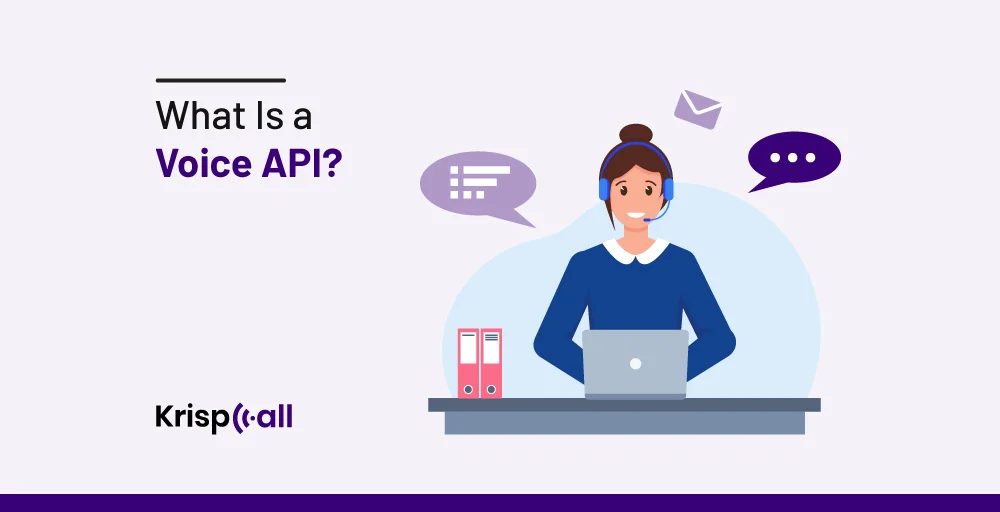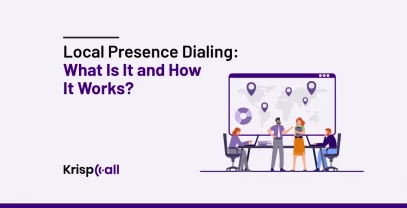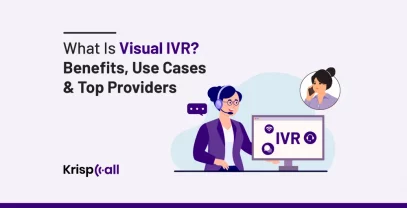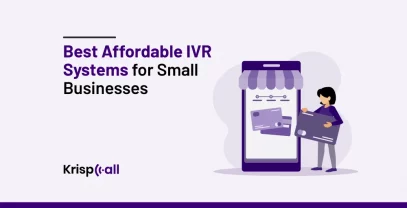Whether you have a small or large customer base, your business software needs a better communication system to keep up with modern needs. Although numerous communication channels are available these days, voice calls are still preferred as the go-to option. 💡
However, from a business point of view, providing exceptional service on those channels at scale has often been a challenge.
No worries—Voice API can handle this for you. With Voice API, you can integrate advanced calling features within your system, focusing on building a better communication system rather than technical stuff.
This blog will show us how we can integrate advanced voice features within our system using Voice API. We also cover various features of Voice API, its benefits, and how it enhances customer and developer capabilities.
🔑 KEY HIGHLIGHTS
- A voice API is a tool that allows software developers to make and receive phone calls.
- Voice API lets you connect to the API and handle all the technical stuff so that you can be focused on building apps.
- Voice API offers various benefits to enhance both user experience and developer capabilities.
- Voice API’s typical cost ranges from $0.0020 to $1 per minute.
What is a Voice API?
A voice API (Application Programming Interface) is a tool that lets software developers add voice-calling features to their applications without needing to be telecom experts. It is a flexible interface that acts as a bridge that connects web applications and the traditional phone network (PSTN) or a VoIP phone.
A voice API provides a set of instructions and tools (API) for developers to program their applications to make and receive phone calls. With it, they don’t need to dive into the technical stuff of telephony instead, they focus on building their apps.
With voice API, you can add telephony features within your application, such as handling huge volumes of calls using IVR service, making outbound calls for sales, call recording, voicemail, and call transcription.
How Does a Voice API Work?
Imagine this scenario: You want to add a “Call Us” button on your application but don’t want to deal with the technical complexities of phone networks. Here’s where Voice API comes in. It lets you connect your application with API with ease.
Here are simple steps on how Voice API works:
- Developer Integration: API works as the intermediate between your software and phone networks. Here, developers use the voice API’s code libraries to write instructions for the app to initiate a call.
- Connection To The Network: When the caller clicks on the “Call Us” button, the voice API initiates contact with the phone network. The network can be PSTN for regular calls or VoIP for internet calls.
- Signal Exchange: It acts as a bridge that transmits and receives voice signals between your application and the third party. It translates digital information into sound waves and vice versa.
- Advanced Basic Calls: Voice API’s features are not limited to simple call features. They provide a variety of functionalities like call recording, caller ID management, advanced IVR, text-to-speech, and many more.
Key Features of Voice API
Voice API provides a variety of features for phone networks. Some of the key features of Voice API are:
- Call Handling: This allows us to make and receive phone calls within our system. It eliminates the complex phone system setup and provides a streamlined process.
- Easy Integration: Developers can integrate voice API features with provided voice call API, well-written documents, and libraries. This reduces the developer’s workload as they provide ease in integration.
- Advanced calling features: Voice API offers a variety of features beyond basic calls. With Voice API, you can record calls, route them through IVR, manage caller IDs, and use text-to-Speech and vice versa.
- Speech Recognition: Voice API allows users to interact with applications through voice. You can navigate through the menu service using voice commands. Voice API converts your spoken voice to text to process your command.
Common Use Cases for Voice API
Your app could have a calling function, and when a caller uses that option, it will connect to the phone network. A Voice API makes this happen. With Voice API, you can use telephony features in your app, along with various other APIs and libraries provided by the Voice API provider.
Voice API does more than just calls. They provide advanced IVR functions for customers to navigate to various services through voice command or keypad input. Basically, anywhere you see phone-related service in an app, there is a high chance of using Voice API tools. Voice API offers a variety of features, including automated scheduled appointments, reminders, and frequent updates.
Benefits of Voice API
Voice API provides an easy way to use the phone network within the application, as it works as a bridge that manages all the complex tasks required to connect your application and phone.
It offers various benefits to enhance both user experience and developer capabilities. A list of benefits of Voice API are:
For Developers
Some of the benefits that help to enhance developer capabilities are:
- Simplify The Development Process: Voice API comes with all the telecommunication knowledge required to integrate voice features into our application. It provides API code, pre-built libraries, and a clear integration instruction guide. It saves time and effort of the developer as it simplifies the process.
- Scalability And Flexibility: Voice APIs are designed to be adaptable to any user base and they can be used in application development in such a way that they can handle small-volume to large-volume calls. Whether you’re a small startup or enterprise business, Voice API perfectly fits you.
- Cost-Effectiveness: Voice API services are cost-affordable as they operate on a pay-as-you-go model. You only pay for the service you use, which makes Voice API a budget-friendly solution for developers.
For User Experience
Lists of benefits of Voice API that enhance the user experience are:
- Efficient And Convenience: With Voice API, users can directly call without switching apps. This eliminates the need to switch between apps or find a phone number to make a call. It saves users time and effort by providing an easy-to-use interface.
- Personalized Service: Voice API offers features to track and analyze data. Integrating Voice API with users’ data helps create a personalized experience for them. Imagine you order on a shopping site with your voice commands, or you can simply order your usual grocery items with just voice commands.
- Improved Customer Service: Users can directly contact you through the “Call Us” buttons. Additionally, businesses can make use of Voice APIs to create Interactive Voice Response (IVR) systems that automate responses to frequently asked questions. This allows users to get the information they need quickly and efficiently without having to wait on hold for a customer service representative that ultimately improve customer service.
How Can a Voice API Give Customers a Better Experience?
Voice API offers various features that give customers a better experience. It provides an easy and convenient way to connect to the support via voice communication methods. With Voice API features, customers can directly make a call without having to switch apps. It saves users time and effort as they eliminate the manual work of switching between apps.
Voice API can also use to build IVR services to customers who can navigate various services through voice commands or keypad input. IVR features include pre-defined answers for FAQs, which help customers get answers independently without needing agents.
Additionally, Voice APIs offer automatic speech recognition features that enable customers to perform actions like placing orders or authenticating identities easily.
How Can a Voice API Streamline Communication Processes?
Voice API acts as a bridge between your apps and phone networks. It works silently in the background to streamline your communication processes and provides an easy interface within your app to make a call. It eliminates the complex phone system setup and provides a streamlined process.
With Voice API, you can make calls effortlessly within an app, as it reduces the switching process between the apps. It also offers advanced IVR service through which users can navigate to various services using voice commands or inputs and can independently acquire the desired answer.
How Much Does a Voice API Cost?
Voice API’s typical cost ranges from $0.0020 to $1 per minute. Prices vary according to service providers, plans, amount of usage, and specific features used.
What Makes a Good Voice API?
A voice API benefits both developers and users. Good Voice API should enhance both developer capabilities and customer experience, however, what makes these actually good depends on various factors.
From a developer’s perspective, a good Voice API should include a simplified integration process, adapt to any customer base, and be cost-effective. From a customer’s perspective, a good Voice API should be convenient and efficient, provide personalized service, and improve customer service by providing an easy interface to navigate.
Conclusion
Voice API provides an easy interface for making a call within your software. It acts as an intermediate bridge between your software and the phone network. Voice API deals with all internal tasks, such as transmitting and receiving voice signals between your application and the third party, which reduces developers’ workloads and simplifies the integration process.
Voice API’s features are not limited to simple call features. They provide a variety of functionalities like call recording, caller ID management, advanced IVR for call routing and FAQ query, text-to-speech, and vice versa.
Voice API can particularly be more beneficial for developers as it represents a transformative technology that empowers them to create voice-enabled applications. Those applications can be used to provide a wide range of capabilities to enhance customer experience.





